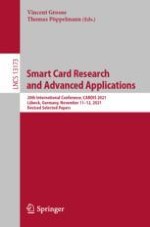2022 | Book
Smart Card Research and Advanced Applications
20th International Conference, CARDIS 2021, Lübeck, Germany, November 11–12, 2021, Revised Selected Papers
Editors: Vincent Grosso, Thomas Pöppelmann
Publisher: Springer International Publishing
Book Series : Lecture Notes in Computer Science
